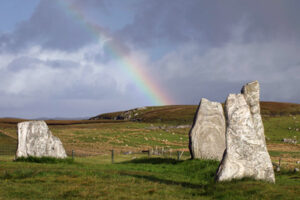The Isle of Lewis Chess Set is one of the most famous and intriguing artifacts in the world of chess. It is believed to be a set of hand-carved chess pieces that originated in the late medieval era, possibly in Norway or Iceland, and were discovered on the Isle of Lewis, a remote island off the northwest coast of Scotland, in the 19th century. The set consists of 78 pieces, including 32 chessmen and 46 other gaming pieces, made of walrus ivory and whales’ teeth, and intricately decorated with Norse and Celtic motifs.
Origins
The exact origins of the Isle of Lewis Chess Set are still shrouded in mystery and subject to various theories and speculations. Some experts believe that the set was crafted in Norway around the 12th or 13th century, during the Viking Age, and brought to the Hebrides, an archipelago that includes the Isle of Lewis, by Norse traders or settlers. Others suggest that the set was made in Iceland or Ireland and transported to the Hebrides by seafarers or migrants.

The Isle of Lewis Chess Set is also believed to have been lost or forgotten for many centuries before it was rediscovered in the mid-19th century. According to one popular story, the set was found in 1831 by a local crofter named Malcolm MacLeod, who stumbled upon a sandbank on the beach of Uig Bay that was eroding due to a storm. Underneath the sand, MacLeod discovered a stone chamber that contained the chess pieces and other artifacts. He sold the set to a collector named Alexander MacKenzie, who eventually donated it to the British Museum in London.

An amazing discovery
The discovery of the Isle of Lewis Chess Set sparked a wave of interest and curiosity in the history of chess and the cultures that produced it. The intricate and imaginative designs of the pieces, which include warriors, kings, queens, bishops, knights, and pawns, have inspired countless artists, writers, and chess enthusiasts. The set has been featured in numerous exhibitions, books, films, and even video games, and has become an iconic symbol of the medieval and Viking eras.
Priceless Chess Pieces?
The value of the original pieces of the Isle of Lewis Chess Set is also a matter of conjecture and debate. While the set is considered priceless and irreplaceable, some pieces have been sold at auctions or private sales for huge sums of money. When the pieces have changed hands, they have fetched significant amounts of money. For example, in 1993, a single knight piece was sold for a large sum at Sotheby’s auction house in London, and in 2019, a complete set was sold for a high price at Christie’s auction house in London.
An international ownership dispute?
However, the ownership and legal status of the Isle of Lewis Chess Set is still a contentious issue. Some Norwegians claim that the set is rightfully theirs, as they argue that it was made in Norway and taken away without permission by the Scottish. They also point out that Norway did not exist as a nation-state at the time the set was made, and that the Hebrides were part of the Kingdom of Norway until the 13th century. On the other hand, the Scottish authorities argue that the set was discovered and acquired in Scotland, and that it has been part of the national heritage and cultural legacy of Scotland for over a century.
To sum up
In conclusion, the Isle of Lewis Chess Set is a fascinating and enigmatic artifact that has captured the imagination of people around the world for centuries. While much about its origins, discovery, and ownership remains uncertain and disputed, the set continues to inspire awe and admiration for its exquisite craftsmanship and




